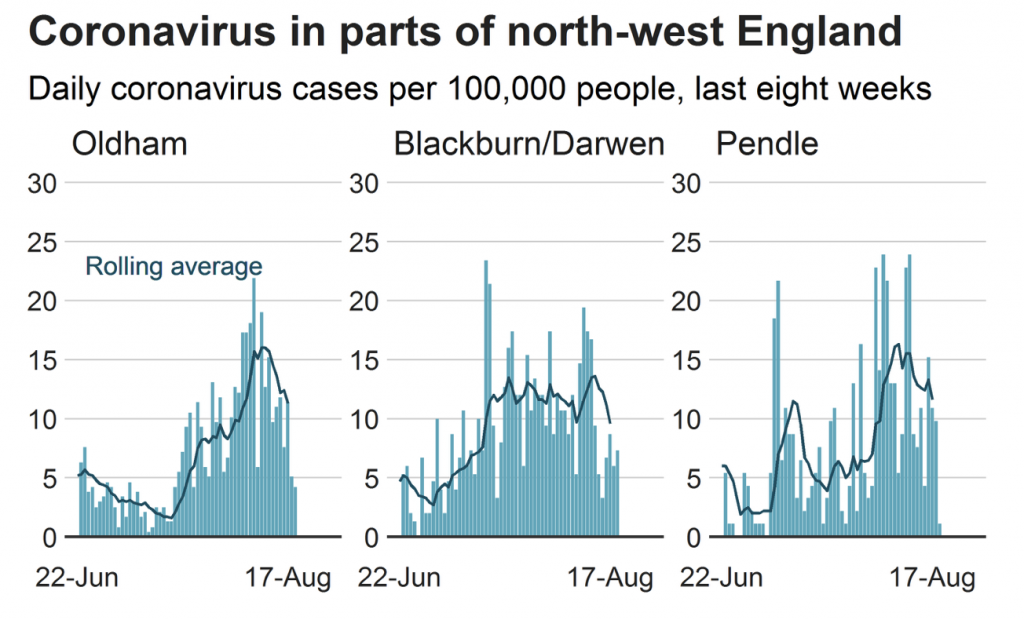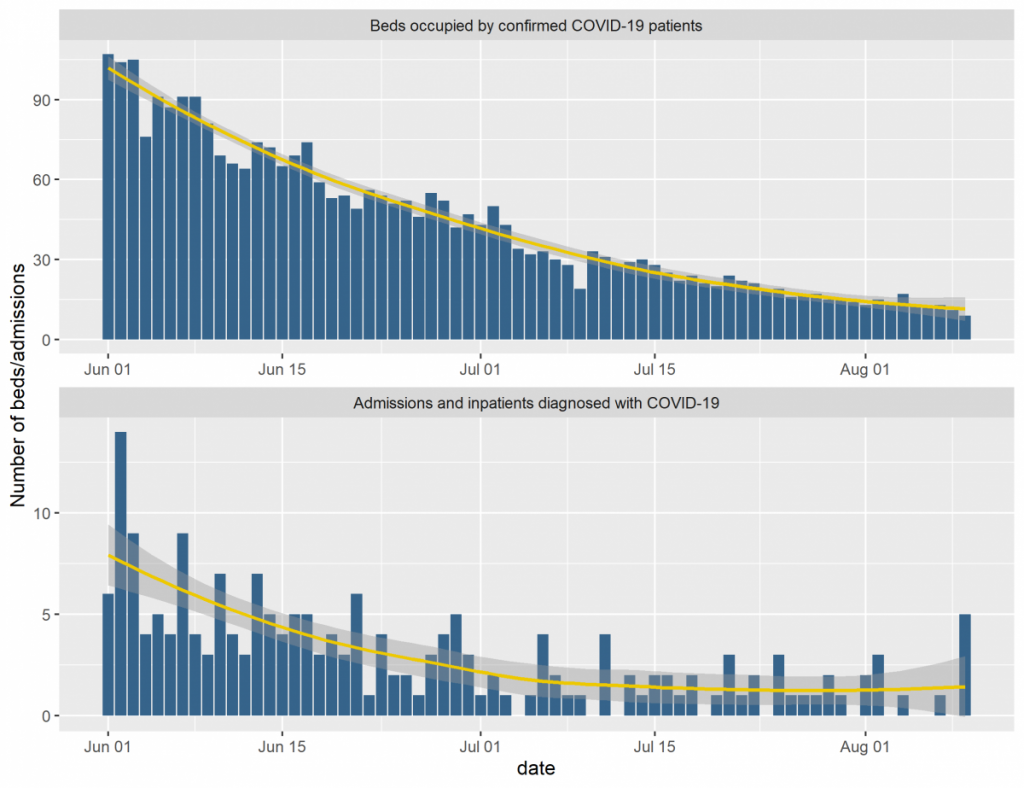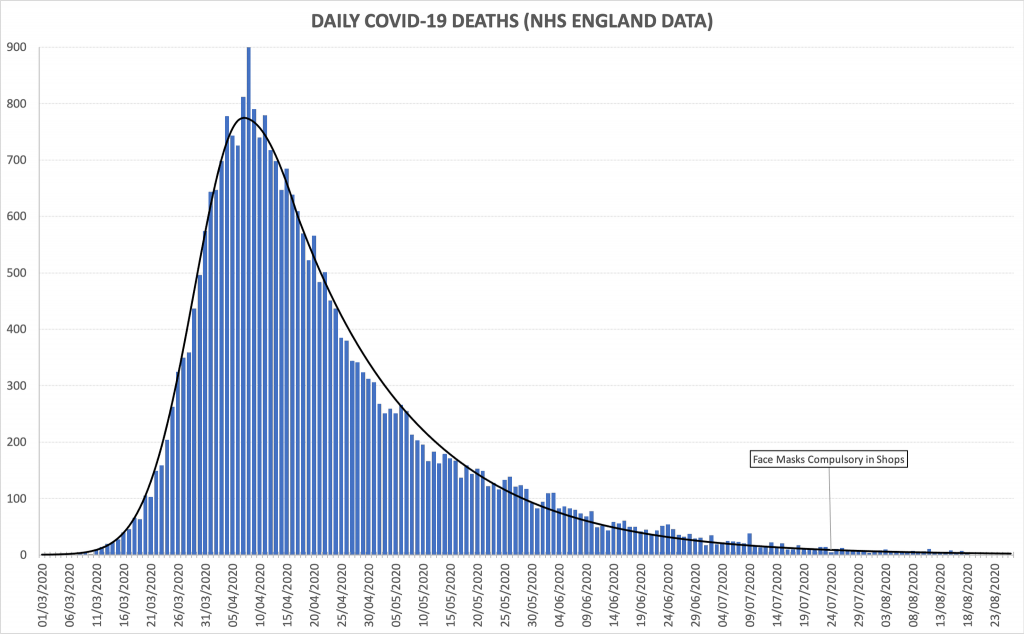New Restrictions For Oldham, Pendle and Blackburn
Sat 3:21 pm +01:00, 22 Aug 2020
Yesterday, the Government announced Oldham and parts of Blackburn and Pendle are facing extra restrictions to deal with local viral outbreaks. Residents in those areas are not allowed to socialise with anyone from outside their household, as of midnight tonight. Trouble is, the case numbers in all three areas are falling as you can see from the above table.
Carl Heneghan and Jason Oke wrote a post for the Centre for Evidence-Based Medicine blog on Thursday urging the Government not to introduce any more restrictions in Oldham. They argue that decisions about whether to introduce local lockdowns should be based on hospitalisation and death data, not case data.
We consider that lockdown measures should be predicated on the impact of the disease. NHS England’s COVID-19 data provides information on the number of people admitted and in a Pennine Acute or Pennine Care Hospital with COVID (these hospitals cover Oldham, Rochdale and North Manchester).
The data shows that 1,252 beds are occupied across the Pennine Hospitals of which nine are occupied by COVID patients as the 9th of August. At the peak on the 12th of April, 290 beds were occupied by COVID patients.
The data also shows that admission remains low at a 7-day moving average of 3 to 4 patients per day, which is down from the preceding week.

In addition to the entirely unnecessary restrictions in Oldham, Pendle and Blackburn, Birmingham has been added to a watchlist as an “area of enhanced support”. The BBC has more.
The Labour leader said the council would announce “as soon as possible” what this meant for people in the city.
“If our previous warnings to keep doing the basics haven’t been enough, this has to be the wake-up call for everyone,” he said. “Wash your hands, wear face coverings wherever possible, keep two metres apart from others and get tested if you have COVID-19 symptoms.”
The Labour leader said the council would announce “as soon as possible” what this meant for people in the city.
“If our previous warnings to keep doing the basics haven’t been enough, this has to be the wake-up call for everyone,” he said.
“Wash your hands, wear face coverings wherever possible, keep two metres apart from others and get tested if you have COVID-19 symptoms.”
But why? Birmingham has 31 cases per 100,000 according to the latest figures, which is lower than it is London (50/100,000), according to the latest ONS Infection Survey data. If Birmingham has been added to the watchlist, why not London?
Incidentally, the latest Infection Survey – which shows no increase in cases on the previous week – also says: “There is no evidence from this survey to say that there is a difference in COVID-19 infection rates between different regions.”
Is the R Number Increasing?

SAGE has announced the R number has climbed above one for the first time since March and, as a result, the entire country may have to go into a second lockdown. According to the Telegraph:
A second national lockdown could be imposed, senior Government advisers have warned, as the upper limit of the R rate pushed over one for the first time since restrictions were lifted.
It continues:
Public Health England surveillance showed case detections in England increased from 5,763 to 6,418 in the week to August 16th, up 11%.
Daily cases are nearly double the number at the beginning of June when lockdown measures were eased. Oliver Johnson, a University of Bristol Professor of Information Theory, said: “The major concern is that R values of this magnitude do not leave a significant margin before the epidemic starts to grow in size again, and raise the possibility that some re-openings may need to be reversed to allow schools to open safely.”
What fresh hell is this? Not only is Public Health England’s data for the week ending August 16th at odds with the ONS Infection Survey data for the week ending August 13th, but an analysis by scientists at the universities of Leeds and Oxford indicates the recent increase in cases hasn’t translated into corresponding increases in hospital admissions and fatalities, even when allowing for the time lag between infections and death. Their analysis shows there should have been 35 fatalities a day by now, but just two deaths were recorded in English hospitals on Friday and none on Thursday, according to NHS England. Admissions are also continuing to fall and consultants say hospitals are “relatively empty” even in hotspots.
It’s time to prise these lockdown fanatics away from Boris Johnson’s ear.
By
https://lockdownsceptics.org/










